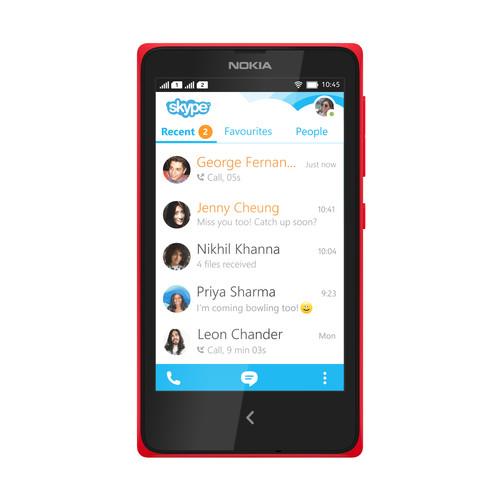In a bid to go after the low-end smartphone segment, Nokia is using Android with its own user interface and Microsoft services on the X, X+ and XL devices.
The last couple of years has seen Android take over the fast growing low-end smartphone market thanks to a wide variety of apps and low price points, which Nokia now hopes to take advantage of with its new X family.
The phones are all based on the Android Open Source Project software.
"That means people will have access to hundreds of thousands of applications right out of the box. With AOSP we benefit from the app and hardware ecosystem, but we have differentiated by adding our own services," said Stephen Elop, executive vice president for Devices & Services at Nokia.
One big question when the first reports of the X family started circulating was whether Microsoft would sell the phones when it takes over Nokia's handset business, and is backing the strategy, according to Elop.
The Google services available on regular Android devices have been replaced by Microsoft services such as Skype, Outlook.com and OneDrive for hosted storage. However, when asked about the availability of Office, Elop did not comment.
Nokia has also added in-house applications such as Here maps.
The phones won't come with Google's Play app store. But users will be able to access apps from Nokia's own Store, as well as more than a dozen third-party app stores and by sideloading. Most Android apps, but not all, will work directly on the X family, Elop said.
The user interface has tiles that can be resized just like the Windows Phone UI, but also the Fast Lane navigation feature from the Asha family, which lets users see most recently used apps.
"What Nokia has done is put a Windows suit on Android. The interface looks very similar to Windows Phone," said Malik Saadi, practice director at ABI Research.
All members of the X family are powered by a 1GHz dual-core processor from Qualcomm and can be equipped with dual SIM cards, which is a must in many developing countries.
The XL has a 5-inch screen with a 800 by 480 pixel resolution, a 2-megapixel front camera and a 5-megapixel camera on the back. There is 768MB of RAM and 4GB of integrated storage.
The X and X+ both have a 4-inch screen with a 800 by 480 pixel resolution and a 3-megapixel camera. Both devices have 4GB of integrated storage, but the X+ has 768MB of RAM instead of 512MG and a microSD card slot.
The Nokia X will go on sale immediately, priced from €89 (US$120) in Asia-Pacific, Europe, India, Latin America, the Middle East and Africa.
The Nokia X+ and Nokia XL are expected to start shipping in the same parts of the world during the beginning of the second quarter, and will cost €99 and €109, respectively.
The new strategy isn't something Nokia has developed overnight, but worked on for a couple of years and the company's choice comes out of necessity, according to Neil Mawston, executive director at Strategy Analytics.
"Microsoft hasn't delivered a low-end platform with Windows Phone 8, and certainly Nokia's Series 40-based Asha phones aren't a credible alternative either," Mawston said.
Those factors make Android the only alternative if Nokia wants to keep traction in a segment of the market where it's still a big fish. The company has over 30 percent market share of feature phones, owners of which are buying cheap smartphones next, according to Mawston.
On Sunday, Microsoft said it is working on making Windows Phone a better fit for low-end phones. Nokia will take advantage of that and launch cheaper Lumias, but at the same time, the cost of X family devices will also drop, according to Elop.
However, even if Nokia felt forced to go with Android, it is a move that comes with several risks. The addition of a Windows-like user interface on top of the Android open source code may end up confusing buyers, but it's a risk the company has to take, Mawston said.
"In that low end of the market -- which tends to be a little less sophisticated -- buyers won't be too worried about what the underlying layers are. They just want a phone that looks good and works well," Mawston said.
Saadi agreed that this push doesn't come without risks: "I think it's an interesting development. However, and this is a big however, if this strategy isn't well implemented and well executed, it could backfire with, for example, the Android devices cannibalizing the low-end of Windows Phone. They need to make a distinction between the two and communicate that," he said.
Having two operating systems could also result in internal strife at Microsoft when its acquisition of Nokia's phone business is approved, according to Saadi.
Where there is risk, there is also a reward. Forked Android or AOSP devices had a 25 percent market share with 71 million shipped smartphones during the fourth quarter -- mainly thanks to China, India and adjacent countries, according to ABI Research. That's more than Apple's iOS, Windows Phone and BlackBerry put together.
Send news tips and comments to mikael_ricknas@idg.com
Join the CIO Australia group on LinkedIn. The group is open to CIOs, IT Directors, COOs, CTOs and senior IT managers.




